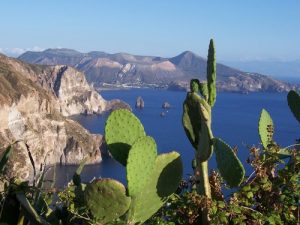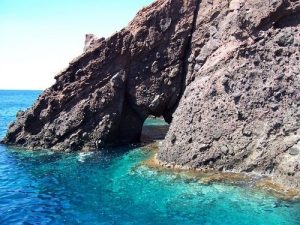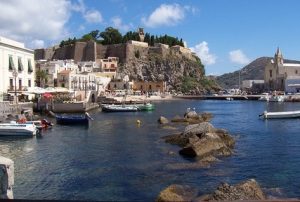 The Aeolian Islands are volcanic creatures born from the active presence of the four elements: air, water, earth and fire. The Aeolian Islands offer the tourists, the researchers and the sea lovers their natural beauty.
The Aeolian Islands are volcanic creatures born from the active presence of the four elements: air, water, earth and fire. The Aeolian Islands offer the tourists, the researchers and the sea lovers their natural beauty.
There is a clean sea still abounding with fish , there are high caves and cliffs, stacks and beaches with black fine sand, solfataras and mountains of white pumice and all the charm of the islanders environments.
You can get here all year by ship and hydrofoils and the easiness of the connections is one of the reasons of the start of tourism.
From Naples you can also depart by car without having to reach Sicily. The hydrofoils, in summer, with several trips everyday, connect the islands with Reggio Calabria, Messina, Palermo, Cefalù and Milazzo.
The climate is mild and in winter the temperature never drops below ten degrees and also out of season there is the possibility of pleasant stays.
The summers are not torrid because mitigated from the sea breeze. In Spring, the vegetation that cloaks the fertile islands is an explosion of colours and scents. Once, the islands were covered by thick woods but today the Mediterranean vegetation has taken the upper hand.
Man has deforested almost all to cultivate vine, olives, capers, legumes and vegetables. The widespread terraces, now abandoned, attest the big human work during the millenniums.
 Man and the geographic characteristics gave a different imprint to every island.
Man and the geographic characteristics gave a different imprint to every island.
Filicudi and Alicudi are an “anti stress refuge” with an uncontaminated environment.
Panarea is the fashionable island, destination of an élite tourism.
Stromboli and Vulcano, rugged and wild, attract young and a little bohemian tourists.
Salina, the green island, with its twin mountains, is perfect for families with children because of its tranquillity.
Lipari, the biggest and most inhabited island, is the seat of municipality, on which all the others islands depend (except Salina), it offers, to those who need comfort and wide spaces, all services, including a fully equipped hospital and a sheltered port.
Lipari
Its town lies at the foot of the imposing fortress of the Castle, the ancient Greek acropolis, and along the inlets, in the north and in the south, you can find Marina Corta and Marina Lunga.
The environments stretch out as far as the bastions and via Garibaldi follows their circular development, from Piazza Mazzini to the delightful Marina Corta (this is the best place to meet people, animated by crowded bars and there you can find our restaurant “Al Pescatore”).
 After a little break on Marina Corta, it’s possible to walk around to discover many charming angles of Lipari.
After a little break on Marina Corta, it’s possible to walk around to discover many charming angles of Lipari.
On the left of the square there is the bell tower of the church of San Giuseppe. Next to it, there is the ancient Chapel of San Bartolomeo of the seventeenth-century. From here, this quiet path takes you to the beach of Porto delle Genti, it is also called in Sicilian “Portinenti” (in Italian Porto di niente: Port of nothing), because it is exposed to all kinds of winds so it can be used only when there is dead calm.
Corso Vittorio Emanuele is the ancient Roman decumanus and it’s still today the principal road.
During the summer it’s always very lively and there are a lot of tourists and ”Liparoti”. In Piazza Mazzini, where there is the municipality, there is the church of Sant’Antonio and from here it’s possible to get to the Castle, originally built as a stronghold, where you find the Eolian Museum.
The Archaeological Aeolian Museum has been there since 1954.
In the entire area of the Castle there are precious traces of the past: inside the pavilions as well as outside with the archaeological excavations. On the right, there is the Church of Santa Caterina, of the XVI-XVIII century, nowadays closed. Nearby, there is the Church of Addolorata, of the XVI century, with a baroque front, wooden altars and golden ornaments; then there is the big Church of Immacolata, built in 1747 with a smooth front.
South of the Church of Santa Caterina and in front of the Church of Immacolata there are two archaeological areas, with remaining parts of four villages dating back to the Bronze Age and parts of the urban installation of the Hellenistic-Roman Age.
Next to the excavations there is a staircase, called Via Del Concordato, built at the beginning of the ‘900 to connect the Cathedral to the town. But the staircase has distorted the original arrangement of the Castle’s fortress and has damaged the archaeological stratifications.
At the bottom, on the right of the staircase, there is the archaeological park, where there are the sarcophagi of the Greek Age coming from the necropolis of Diana’s quarter. In 1976 an open-air theatre was built, from the Greek model, with a wonderful natural scenography. It is an oasis of peace and tranquillity.
There is also another Church, Santa Maria delle Grazie, built between the XVII and XVIII century, on top of an existing construction.
The Cathedral of San Bartolomeo stands majesticly with its Neo-Baroque bell tower next to it.
It was seriously damaged in 1544 during the raid of the pirate Barbarossa. It was rebuilt and decorated several times. It preserves the transept and the presbytery of the ancient Norman church. The reconstruction was started in 1500 in Gothic style and was finished in 1600 in Baroque style.
The interior of the church has three naves with vaults —frescoed— in 1700 with scenes of the Ancient Testament. Behind the altar there is a statue in silver of San Bartolomeo of the 1700.
From the interior of the church it is possible to accede to the precious cloister of the Norman Abbey. Only three sides have remained, because one side was incorporated to the right nave of the Cathedral after the extension. The following construction of Palazzo del Vescovo used the spaces of the portico and it walled the columns so it has preserved them for 800 years. We had lost trace of them until the recent restoration that has given us back a master piece.
 The Aeolian Museum, founded in 1954 by Luigi Bernabò Brea e Madeleine Cavalier, exposes in various parts of the Castle of Lipari, detailed remains of the excavations conducted by the two researchers in the Aeolian Archipelago since 40s until today. Because of its characteristics of a “live” museum, in strict and constant relationship with the territory, it is directly connected with the progress of the archaeological studies. The exposition, though in the scientific rigour, is imprinted according to the didactic conception of their creators, with the criterions of illustrative clearness that offers a useful and pleasant visit even to somebody who is not an expert. For example, the historic reconstruction with the original parts of the excavations has a particular impact on the public. The visit starts from the prehistoric section, in the interior of Palazzo Vescovile, built at the beginnings of the XVIII century including parts of the Norman Monastery of the XII century. This section is dedicated to the different cultures found on the island of Lipari since the first human allocation of the early centuries of the V millennium.
The Aeolian Museum, founded in 1954 by Luigi Bernabò Brea e Madeleine Cavalier, exposes in various parts of the Castle of Lipari, detailed remains of the excavations conducted by the two researchers in the Aeolian Archipelago since 40s until today. Because of its characteristics of a “live” museum, in strict and constant relationship with the territory, it is directly connected with the progress of the archaeological studies. The exposition, though in the scientific rigour, is imprinted according to the didactic conception of their creators, with the criterions of illustrative clearness that offers a useful and pleasant visit even to somebody who is not an expert. For example, the historic reconstruction with the original parts of the excavations has a particular impact on the public. The visit starts from the prehistoric section, in the interior of Palazzo Vescovile, built at the beginnings of the XVIII century including parts of the Norman Monastery of the XII century. This section is dedicated to the different cultures found on the island of Lipari since the first human allocation of the early centuries of the V millennium.
In the last room we can see to the topography of the Greek Lipàra and the Roman city that it had turned into.
